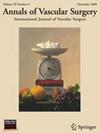Wound Healing in Older Adults after Major Lower Extremity Amputation
IF 1.4
4区 医学
Q3 PERIPHERAL VASCULAR DISEASE
引用次数: 0
Abstract
Background
The higher prevalence of multiple chronic conditions and frailty among older adults may increase the physiologic demand required for wound healing after a major lower extremity amputation (LEA). After below knee amputations (BKA), patients generally have improved prosthetic fitting rates, postoperative ambulation, and quality of life compared to an above knee amputation (AKA). However, the benefit of a BKA must be weighed against the risk of wound complications. The purpose of this study is to examine the association between advanced age and wound healing in our contemporary cohort of patients who underwent LEA.
Methods
Our study reviewed all patients who received LEA at 2 major academic healthcare systems between January 2015 and December 2022. Patients with prior ipsilateral LEA were excluded. The exposure of interest was advanced age, defined as age over 80 years old, and the primary outcome was time to wound healing (defined as clinical documentation of a healed amputation incision). Chi-squared test was used to evaluate advanced age and prosthetic fitting after LEA and Cox proportional hazard models were fit to examine the relationship between advanced age and time to wound healing after a LEA.
Results
Among 597 patients who underwent LEA, 8.9% (n = 53) were over the age of 80. Over one-third of all patients underwent AKA (n = 235, 39.4%) and patients with advanced age represented 12.3% of this group. There was no statistically significant difference detected between the proportion of those with advanced age who were fit for prosthetic compared to those under age 79 who were fit for prosthetic (47.1% vs 58.5%, P = 0.11). The median time to wound healing was faster among those with advanced age, even when stratified by level of LEA (Table 1). Advanced age was associated with faster wound healing (hazard ratio [HR] 1.42; 95% CI, 1.06–1.87).
Conclusions
In our cohort of patients, those with advanced age healed faster than their younger counterparts at both levels of LEA and were equally likely to receive a prosthetic after LEA. Age alone should not be used as a factor in determining eligibility to undergo LEA or receipt of prosthetic. Future studies will evaluate other clinical characteristics that are associated with successful wound healing among adults 80 and older.
求助全文
约1分钟内获得全文
求助全文
来源期刊
CiteScore
3.00
自引率
13.30%
发文量
603
审稿时长
50 days
期刊介绍:
Annals of Vascular Surgery, published eight times a year, invites original manuscripts reporting clinical and experimental work in vascular surgery for peer review. Articles may be submitted for the following sections of the journal:
Clinical Research (reports of clinical series, new drug or medical device trials)
Basic Science Research (new investigations, experimental work)
Case Reports (reports on a limited series of patients)
General Reviews (scholarly review of the existing literature on a relevant topic)
Developments in Endovascular and Endoscopic Surgery
Selected Techniques (technical maneuvers)
Historical Notes (interesting vignettes from the early days of vascular surgery)
Editorials/Correspondence

 求助内容:
求助内容: 应助结果提醒方式:
应助结果提醒方式:


